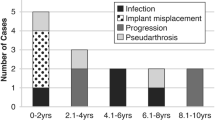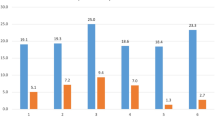Abstract
Purpose
The objective of this study is to determine whether routine follow-up 5 years after adolescent idiopathic scoliosis (AIS) surgery is likely to affect postoperative care for patients treated with high-density pedicle screw constructs, when routine 2-year follow-up has been performed.
Methods
We reviewed 80 patients undergoing surgery for AIS using high-density pedicle screw constructs and followed routinely 2 and 5 years after surgery. Quality of life (QOL) was assessed using the SRS-30 outcome questionnaire. Reoperations occurring between 2 and 5 years after surgery were identified.
Results
Curve correction and QOL were similar between 2- and 5-year visits. Two patients required revision surgery after presenting during unplanned visits between the 2- and 5-year follow-ups. One patient presented at the routine 5-year visit with an asymptomatic undisplaced rod fracture without loss of correction, and it was decided to follow-up only as needed.
Conclusions
In AIS patients for whom routine follow-up 2 years after surgery using high-density pedicle screw constructs was uneventful, additional routine 5-year follow-up is not likely to affect postoperative care and revision rate. Patients developing complications and needing reoperation between 2 and 5 years after surgery will most likely present during unplanned visits rather than during routine follow-up appointments. Easy access to emergent visits on an as-needed basis is therefore important for this population if routine 5-year follow-up is not planned.
Graphical abstract
These slides can be retrieved under Electronic Supplementary Material.

Similar content being viewed by others
References
Ahmed SI, Bastrom TP, Yaszay B et al (2017) 5-year reoperation risk and causes for revision after idiopathic scoliosis surgery. Spine 42:999–1005
Lonner BS, Ren Y, Yaszay B et al (2018) Evolution of surgery for adolescent idiopathic scoliosis over 20 years: have outcomes improved? Spine 43:402–410
Bharucha NJ, Lonner BS, Auerbach JD et al (2013) Low-density versus high-density thoracic pedicle screw constructs in adolescent idiopathic scoliosis: do more screws lead to a better outcome? Spine J 13:375–381
Gebhart S, Alton TB, Bompadre V et al (2014) Do anchor density or pedicle screw density correlate with short-term outcome measures in adolescent idiopathic scoliosis surgery? Spine 39:E104–E110
Li M, Shen Y, Fang X et al (2009) Coronal and sagittal plane correction in patients with Lenke 1 adolescent idiopathic scoliosis. A comparison of consecutive versus interval pedicle screw placement. J Spinal Disord Tech 22:251–256
Quan GMY, Gibson MJ (2010) Correction of main thoracic adolescent idiopathic scoliosis using pedicle screw instrumentation. Does higher implant density improve correction? Spine 35:562–567
Rushton PRP, Elmalky M, Tikoo A et al (2016) The effect of metal density in thoracic adolescent idiopathic scoliosis. Eur Spine J 25:3324–3330
Clements DH, Betz RR, Newton PO et al (2009) Correlation of scoliosis curve correction with the number and type of fixation anchors. Spine 34:2147–2150
Larson AN, Polly DW Jr, Diamond B et al (2014) Does higher anchor density results in increased curve correction and improved clinical outcomes in adolescent idiopathic scoliosis? Spine 39:571–578
Mac-Thiong J-M, Ibrahim S, Parent S et al (2017) Defining the number and type of fixation anchors for optimal main curve correction in posterior surgery for adolescent idiopathic scoliosis. Spine J 17:663–670
Sanders JO, Diab M, Richards SB et al (2011) Fixation points within the main thoracic curve. Does more instrumentation produce greater curve correction and improved results? Spine 36:E1402–E1406
Kuklo TR, Potter BK, Lenke LG et al (2007) Surgical revision rates of hooks versus hybrid versus screws versus combined anteroposterior spinal fusion for adolescent idiopathic scoliosis. Spine 32:2258–2264
Lykissas MG, Jain VV, Nathan ST et al (2013) Mid- to long-term outcomes in adolescent idiopathic scoliosis after instrumented posterior spinal fusion. A meta-analysis. Spine 38:E113–E119
Garg S, Kipper E, LaGreca J et al (2015) Are routine postoperative radiographs necessary during the first year after posterior spinal fusion for idiopathic scoliosis? A retrospective cohort analysis of implant failure and surgery revision rates. J Pediatr Orthop 35:33–38
Hwang SW, Samdani AF, Marks M et al (2013) Five-year clinical and radiographic outcomes using pedicle screw only constructs in the treatment of adolescent idiopathic scoliosis. Eur Spine J 22:1292–1299
Author information
Authors and Affiliations
Corresponding author
Ethics declarations
Conflict of interest
No funding was received for this research. There is no conflict of interest directly related to this research. JMMT, SP and HL are co-founders and board members of Spinologics Inc. RR and JJ have no competing interests associated with this work.
Electronic supplementary material
Below is the link to the electronic supplementary material.
Rights and permissions
About this article
Cite this article
Mac-Thiong, JM., Remondino, R., Joncas, J. et al. Long-term follow-up after surgical treatment of adolescent idiopathic scoliosis using high-density pedicle screw constructs: Is 5-year routine visit required?. Eur Spine J 28, 1296–1300 (2019). https://doi.org/10.1007/s00586-019-05887-5
Received:
Accepted:
Published:
Issue Date:
DOI: https://doi.org/10.1007/s00586-019-05887-5




